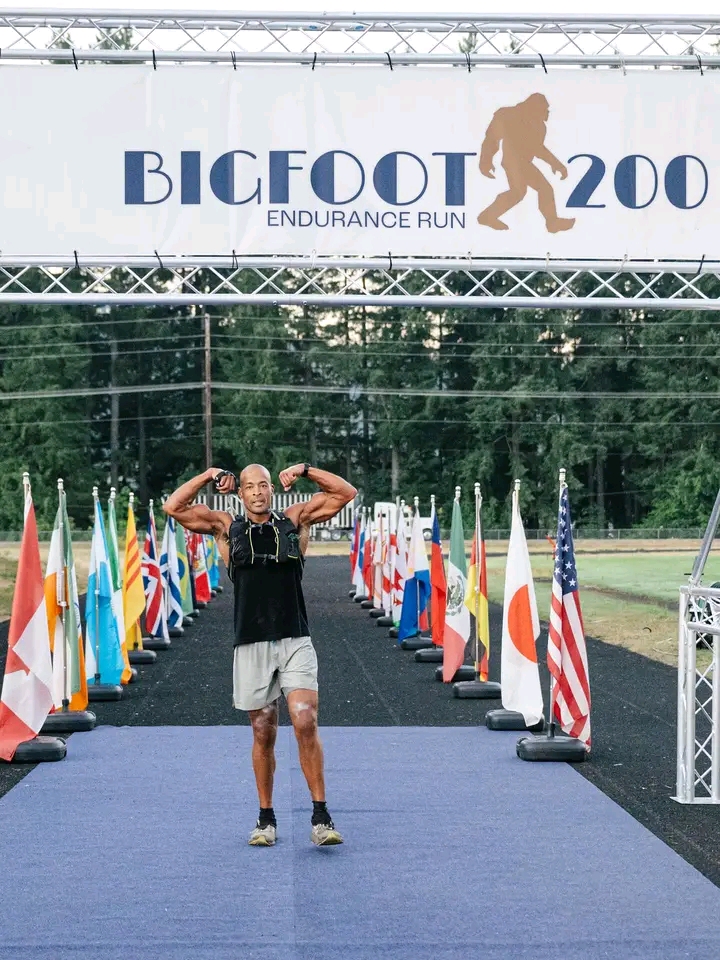David Goggins Shares Shocking Secret After Running 200 Miles in 66 Hours at Age 50
Ultrarunning Legend Conquers the Bigfoot 200—and Reveals the Mental Weapon That Pushed Him Through
—
Washington, August 15, 2025 — In one of the most grueling endurance feats of the year, 50-year-old ultrarunner and retired Navy SEAL David Goggins completed the 2025 Bigfoot 200, a punishing 200-mile ultramarathon through the Cascade Mountains of Washington, clocking in at 66 hours, 4 minutes, and 17 seconds. While his finish time placed him 23rd out of 159—well behind the race leader Kilian Korth’s 45-hour finish—it wasn’t the time on the clock that stunned followers, but what Goggins revealed afterward.
“I hallucinated my younger self telling me to stop,” Goggins said. “That’s when I knew the real race had started.”
This chilling confession came during a raw post-race interview, where Goggins detailed not just the physical, but the psychological warfare that unfolded over nearly three days of continuous movement through rugged ridgelines, alpine passes, glacier-fed valleys, and over 40,000 feet of elevation gain and loss.
—
The Race That Breaks the Unbreakable
The Bigfoot 200 isn’t just a race—it’s an ordeal. Spanning remote wilderness with little to no connectivity, runners are on their own for long stretches. Aid stations, while spaced generously, often become mental traps. “Most people treat them like finish lines,” Goggins said. “That’s when they stop. That’s when they lose.”
In true Goggins fashion, he spent over 20 hours at aid stations, not to recover luxuriously, but to strategically reset—fueling, adjusting gear, and taking short 10–15 minute naps when absolutely necessary. Even his pace—an average of about 4.1 mph while moving—was deceptively steady, reflecting a deliberate focus on relentless forward motion, not racing others.
—
The Shocking Secret: A Mental Trick from Hell Week
But what shocked fans and fellow athletes wasn’t just the hallucinations or the finish—it was the mental trick he used to survive the darkest moments.
“In SEAL training, during Hell Week, I learned to compartmentalize pain by giving it a room in my head—but locking the door. Out here, I used the same trick. I didn’t try to block the pain. I gave it a place to scream where I couldn’t hear it,” Goggins revealed. “That’s what got me through mile 187 when my legs stopped responding.”
This “mental room” strategy, as Goggins calls it, became the focal point of his post-race breakdown. He explained that during long-distance races, the mind begins to betray the body far before the muscles or joints give out. “You’re not tired. You’re just being lied to,” he said, referencing his now-iconic 40% Rule, which suggests that most people quit when they’ve only tapped into 40% of their true capacity.
—
Beyond the Finish Line
What separates Goggins from other elite athletes is that he’s not racing against others—he’s racing against weakness itself. The 200-mile finish at age 50 isn’t just a testament to his durability, it’s a philosophical statement: that boundaries, even those built by time and age, are mostly imaginary.
“This wasn’t a speed run,” Goggins noted. “It was a spirit check.”
His placement wasn’t near the top, but that was never the point. With every aid station passed, every hallucination ignored, every ache silenced in his mental chamber, Goggins chipped away at what he calls “the illusion of limitation.”
—
Lessons from Goggins: Move, No Matter What
The message Goggins left with was simple—but brutal in its clarity.
> “The finish line doesn’t exist. There’s only movement. You stop moving, you die. That’s the lesson.”
Whether you’re trying to push through a brutal gym session, a tough week at work, or a personal low point, Goggins’ experience offers more than motivation—it offers a method. The next time you feel like quitting, ask yourself if you’re truly at your limit—or just at your 40%.
—
In Summary
David Goggins, age 50, completed the Bigfoot 200 in 66:04:17, placing 23rd out of 159 finishers.
The course includes 200 miles of extreme terrain and 40,000+ ft of elevation gain/loss.
Goggins revealed a mental compartmentalization technique from Navy SEAL training to manage pain.
He endured hallucinations, intense fatigue, and strategic pauses, pushing beyond the breaking point.
His story reinforces his philosophy: limits are illusions and pain is a teacher, not a stop sign.
—
Next Up for Goggins? He’s hinted at tackling an even more brutal self-designed “race” in 2026—one that involves a mix of ultrarunning, ocean swimming, and mountaineering. Because, in his words:
—


